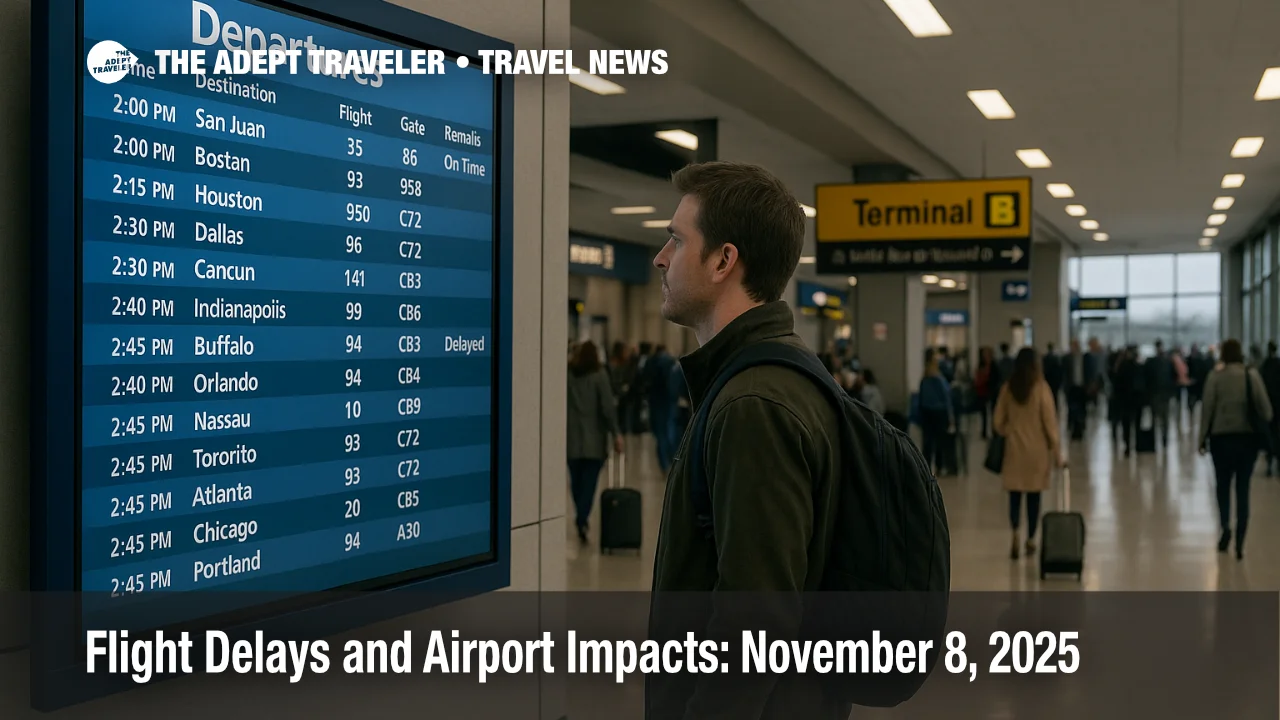Flight Delays and Airport Impacts: November 9, 2025

Key points
- FAA operations plan lists active ground delay programs at San Diego, Chicago O'Hare, and Newark with additional staffing triggers across major facilities
- Low ceilings and wind affect Boston and the New York area while storms and low visibility add friction in Central Florida
- FlightAware shows about 1,300 U.S. cancellations as of mid morning Central Time with totals rising into afternoon banks
- Cuts rise to 6 percent on Tuesday, November 11, then to 10 percent by Friday, November 14 under the FAA directive
Impact
- Pad Connections And Buffers
- Allow extra time at hubs and during late day banks, especially if connecting through New York, Chicago, Boston, or Central Florida
- Move To Earlier Departures
- When possible rebook to morning flights to avoid compounding afternoon GDP delays
- Use Waivers And Self-Service
- Check airline travel waivers and same-day change tools before heading to the airport
- Watch For Pop-Up Programs
- Ground stops or new GDPs may be issued for BOS, MCO, DCA, JFK, and LGA later today
- Verify Runway And Construction Impacts
- Expect throughput constraints at airports with active closures such as EWR, BOS, IAH, MCO, and DEN
FAA staffing constraints and pockets of weather are setting the tone for Sunday travel across the United States. The Air Traffic Control System Command Center's operations plan shows active ground delay programs at San Diego International Airport (SAN), Chicago O'Hare International Airport (ORD), and Newark Liberty International Airport (EWR), with additional staffing triggers at multiple towers and TRACONs. As of mid morning Central Time, FlightAware reported roughly 1,300 cancellations within, into, or out of the United States, with totals expected to climb as afternoon banks build. Travelers should add buffer time, move to earlier departures when possible, and use airline self-service tools.
FAA operations picture
Sunday's plan adds Philadelphia Terminal and New York TRACON to staffing initiatives, removes prior Lake Erie reroutes, and keeps Los Angeles managed tactically. The FAA lists active GDPs at SAN until 959 p.m. local, at ORD until 959 p.m. local, and at EWR until 11:59 p.m. local, with Toronto Pearson also under a program. Low ceilings and wind constrain Boston Logan International Airport (BOS) and the New York area, while Charlotte Douglas International Airport (CLT) is flagged for low ceilings and visibility. Central Florida, including Orlando International Airport (MCO), carries thunderstorm, low ceiling, and low visibility risks. The plan also highlights snow and low visibility potential around Detroit, the Chicago satellite TRACON, and Minneapolis, along with wind at George Bush Intercontinental Airport (IAH), and morning marine layer at Los Angeles International Airport (LAX) and San Diego. Additional planned ground stops or delay programs are possible later today for BOS, MCO, Ronald Reagan Washington National Airport (DCA), John F. Kennedy International Airport (JFK), and LaGuardia Airport (LGA). Runway and equipment items include EWR weekend closures on 4L, 22R, BOS 09, 27 closed, an IAH runway closure, and work at MCO, SFO, DEN, SEA, and others. These constraints reduce throughput and increase delay spacing, which magnifies missed connections as banks stack into the evening.
Latest developments
FlightAware's live tracker shows U.S. cancellations around the low-1,000s by mid morning Central Time, with Saturday's nationwide cancellations having exceeded 1,900. Newsrooms tracking the shutdown's impact report a third straight day of elevated cancellations and continuing FAA-directed flight reductions. Expect counts to trend higher into the afternoon and evening as programs meter arrivals and as convective weather and ceilings hold in parts of the East and Central Florida.
Analysis
The near term risk profile favors earlier flights, protected minimum connection times, and nonstop substitutions. ORD and EWR programs tend to propagate delays across hub-and-spoke networks, so even travelers not touching New York or Chicago can feel the effects through aircraft and crew rotations. BOS, JFK, LGA, and MCO are on the watch list for additional initiatives later today, which can push missed connections into the evening wave. If you can move to a morning or midday departure, do it. If not, pad ground time, select longer connection options, and confirm backup seats on later flights. Most airlines have posted waivers and flexible change tools during the FAA-directed reductions, so check your carrier's manage-trip page, and confirm that any no-fee changes preserve your fare class and seat. Keep an eye on runway and taxiway work at airports like EWR, BOS, IAH, MCO, and DEN since work zones reduce capacity even in clear weather.
Final thoughts
The combination of FAA staffing limits and localized weather is likely to keep delays elevated through the evening. Use the primary keyword when you search carrier pages, for example, "flight delays and airport impacts," and refresh the FAA status and FlightAware counts before leaving for the airport. Travelers who shift earlier, protect connections, and leverage waivers will ride out today's disruptions with fewer surprises.
